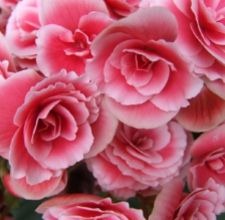If you want to have color in your garden, you will love cultivating tuberous begonias. These begonias, like potatoes, are stem tubers. They store food in their stems to form new plants during the growing season. A tuberous begonia will produce multiple flowers from the buds and eyes on the surface of its stem, according to online resource Garden Hive. Tuberous begonias bloom, in a range of colors and flower forms, from late spring until autumn. If you live in a warmer climate your begonias may even bloom into the winter months.
- Difficulty:
- Moderately Easy
Instructions
things you’ll need:
- Garden trowel
- Seed trays
- Potting compost
- Watering can
- Flower pots (5 inch and 9 inch)
- Sand (dry)
- Container
 Water the compost until it is wet to the touch.
Water the compost until it is wet to the touch.
Fill seed trays with potting compost using your trowel. Sprout tubers in seed trays in February or March. Bury the tubers into a potting compost in the trays with the "bumpy" side up (these are new buds). Place them just below the surface of the compost and at least 2 inches apart then the the soil is slightly until it is wet to the touch.
 Use a garden spade to plant tubers.
Use a garden spade to plant tubers.
Plant the tubers into 5-inch pots (after the plants have sprouted and the leaves are beginning to show). Fill the pots to 1 inch from the top with compost using your trowel then dig a small hole into the compost and place the plant into the hole and cover the root ball with compost.
 Do not leave plants out all night until there is no frost.
Do not leave plants out all night until there is no frost.
Transplant your plants in April, into a 7-inch pot or larger (depending on how large the plant has grown). Acclimatize the potted plants by taking them outside and putting them in a covered area in the day time and taking them back inside at night. Leave the plants out all night after a few weeks if there is no frost.
 Let the Begonias bloom until October.
Let the Begonias bloom until October.
Place the potted plants in a moist, partially shaded area with soil rich in humus. Plants should bloom until October, according to online resource In The Garden. At the end of the growing season, reduce the water you give to the plants, then stop all watering and feeding when the leaves start to turn yellow. Let the plants dry out.
- Store the tubers in dry sand until next year.
Empty the plants from their pots when they have completely dried out, then store them in a dry place that is free from frost. Store the tubers in a container of dry sand until the next ‘ growing season.
Tips & Warnings
-
Begonias grow best in temperatures between 65 degrees and 70 degrees F.
-
Begonias enjoy a liquid fertilizer with potash that is given following the manufacturers directions.
-
If stems begin to droop or break, use craft sticks to prop them up.
-
Begonias are susceptible to fungal diseases, including soft rots, botrytis and mildew.


Deprecated: strpos(): Passing null to parameter #1 ($haystack) of type string is deprecated in /home/agriviek8Qv/agriviet.net/public_html/wp-includes/comment-template.php on line 2522